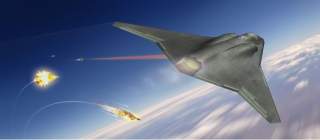Northrop Grumman Is Building Laser Weapons to Save America's Future Fighter Aircraft from Missile Attacks
SHiELD's up?
Northrop Grumman is working on developing a new laser weapon that would defend next-generation fighter aircraft from incoming missiles under a contract with the U.S. Air Force Research Laboratory (AFRL).
Under the terms of the Aug. 23 contract, Northrop Grumman will develop and produce the beam control part of what the AFRL calls the Self-Protect High Energy Laser Demonstrator (SHiELD) Advanced Technology Demonstration (ATD) program. Essentially, the SHiELD is a pod-mounted airborne laser weapon demonstrator that would use directed energy for aircraft self-defense.
“Our Northrop Grumman-led team is integrating an innovative beam director with proven beam control technologies to help the Air Force define and successfully demonstrate a laser weapon capability for current and next generation aircraft,” W. Mark Skinner, Northrop Grumman Aerospace Systems’ vice president of directed energy, said in a statement.
Northrop’s portion of the SHiELD is the crucial beam control system. The beam control system characterizes the flight environment for atmospheric disturbances that could distort the laser beam. It also acquires and tracks incoming targets—and then determines an aim point for the laser. The system would then “shape” and focus the outgoing laser beam onto the target—which could be a missile or potentially an even enemy aircraft.
According to the company, Northrop is developing the beam control system under a segment of the SHiELD ATD program called the SHiELD Turret Research in Aero Effects—or STRAFE. The AFRL will ultimately integrate the STRAFE beam control system with a laser source, power source and cooling systems. The AFRL is developing those other components for the SHiELD ATD under separate contracts.
The AFRL vision for SHiELD is a pod that could be fitted on to both current and future combat aircraft to drastically improve their survivability inside heavily defended airspace. The AFRL’s current plans call for SHiELD to be flight tested on a tactical aircraft flying at supersonic speeds to prove out the concept in a dynamic environment. Flight-testing the integrated SHiELD system should start by 2019 if all goes as planned.
If the SHiELD program succeeds, the Air Force could choose to develop an operational version of the system to protect its fourth-generation fighters such as the Boeing F-15C Eagle, F-15E Strike Eagle and Lockheed Martin F-16 Fighting Falcon to make them more survivable inside hostile airspace—potentially replacing or supplementing conventional chaff and flare decoys in those jet’s defensive suites. In addition to the Air Force fleet, the SHiELD technology might be useful for the U.S. Navy’s Boeing F/A-18E/F Super Hornet and EA-18G Growler fleets.
The Air Force might also consider building SHiELD technology into the next-generation Penetrating Counter-Air replacement for the Lockheed Martin F-22 Raptor—where it could be integrated onto the airframe from the outset. However, a podded SHiELD system would not be suitable for fifth-generation fighters like the F-22 or Lockheed Martin F-35 Joint Strike Fighter because external stores would compromise the jets’ stealth attributes. Likewise, it might be difficult to integrate SHiELD into the Northrop Grumman B-2 Spirit and B-21 Raider for similar reasons.
However, while direct energy weapons hold a lot of promise for the future, the technology has failed to deliver time and again since at least the Reagan administration. It remains to be seen if directed energy weapons have progressed to a point where they might realistically be fielded with in the next decade or so.
Dave Majumdar is the defense editor for The National Interest. You can follow him on Twitter: @davemajumdar.
Image: Northrop Grumman.

